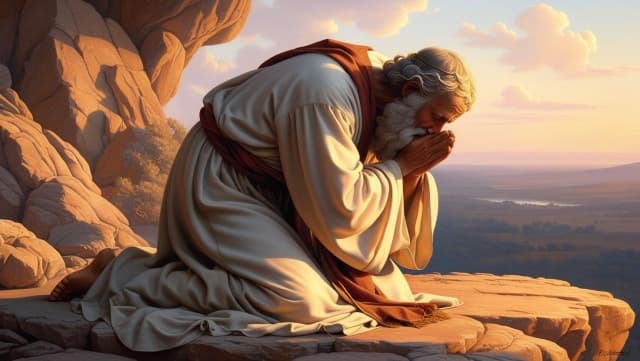The Messianic Hope of the Old Testament
According to the narratives of the biblical text, David, the second king of Israel, was one of the greatest kings Israel ever had. A leader, both in battle and in politics, a good administrator, organized, and a musician, David became a hero to his people very early in his life. Because of the exceptional qualities ascribed to him in the biblical text, to the biblical writers, David became the model for all the kings who succeeded him, both in Judah and in Israel.
The dynasty of David obtained its religious legitimation by the so-called Nathan prophecy found in 2 Samuel 7 (cf. 2 Samuel 23:l-7) where God made an everlasting covenant with David (2 Samuel 23:5), a covenant in which God promised to establish the throne of his kingdom forever (2 Samuel 7:13). In this covenant between God and David, the dynasty of David was promised eternal existence (2 Samuel 7:16, 29; cf. also Psalm 89:3-4, 29-37; 132:11-12).
Thus, the Messianic expectation in Israel is linked to God’s covenant with David and to a well-developed world of ideas that came with the aggrandizement of David and the idealization of the Davidic kingdom. This Messianic ideal in Israel grew as the monarchy declined. It appears that the beginning of what is known as the Messianic hope in Israel begins to take place in the eighth century, primarily with some of the oracles of the pre-exilic prophets Isaiah and Micah. These two prophets begin to speak of a deliverer in terms which suggest that this deliverer will be an ideal king like David. Passages such as Isaiah 9:l-7; 11:l-9 and Micah 5:2-4 speak of a “shoot will come up from the stump of Jesse” and a ruler who will come from Bethlehem, one “whose origins are from of old, from ancient times.” The ancient time mentioned by Micah is a reference to the times of David.
The Messianic hope that God would send an ideal king, one who would be like David, increased during and after the exile, at a time when the people in Babylon hoped for a return to the promised land and the reestablishment of the Davidic kingdom. However, the lack of detail about a Messianic expectation in the prophetic books indicates that a developed Messianic hope in Israel did not come into full bloom until later in post-exilic times.
Later additions to the prophetic books provide a good overview of the development of the prophetic hope in the exile and the post-exilic period. For instance, an addition to Hosea declares that the Son of David would be the bond of union among the tribes (Hosea 3:4-5). An addition to Amos says that David’s tent, which had fallen down, would be set up again (Amos 9:11). Micah promised that the remnant of Israel would become a strong people and the Lord would reign over them and that Bethlehem would be the birth place of the son of David who would rule in Israel (Micah 5:2-4). Isaiah said that David’s throne would be occupied forever and that the Gentiles would come to the root of Jesse (Isaiah 11:10). Jeremiah (Jeremiah 33:15-16) and Ezekiel (34:23-24) pointed to the reestablishment of the kingdom under one Shepherd and King, who should be David (that is, a son or descendant of David). The book of Daniel speaks about the coming of the Son of Man who should become ruler over nations (Daniel 7:13-14). Haggai and Zechariah speak of a son of David who was destined to be the great temple builder who would rule as the Lord’s “signet ring” (Haggai 2:23) and as the Lord’s servant and he would be known as “the Branch” (Zechariah 3:8).
In the inter-biblical period, at a time when many people began to believe that revelation had ceased, the expectation of a coming Messiah grew. The idea of a coming Messiah is present in the several apocalyptic writings of this time.
William Barclay, in his book, Jesus As They Saw Him (London: SCM Press, 1962), pp. 112-137,
developed a list of events and ideas associated with the coming of the Messiah. This list was drawn from the Old Testament and from the literature of the inter-biblical period:
(1) Elijah will return to be the herald and the forerunner of the Messiah.
(2) The Messianic Age was to begin with what was called the “travail of the Messiah.”
(3) Before the arrival of the Messianic age, there will be a time of terror.
(4) This time of terror will be a time of complete disintegration of society.
(5) The coming of the Messiah will be preceded by a time of cosmic upheaval.
(6) The beginning of the Messianic Age will be a time of judgment.
(7) The Gentiles will have a place in the Kingdom.
(8) The time of the Messiah will be a time for the ingathering of Israel.
(9) In the Messianic Age, Jerusalem would be restored and renewed.
(10) The resurrection of the dead is a regular hope and expectation of the Messianic Age.
At the beginning of the first century, the Messianic hope in Israel was in full bloom. In the Judaism of the time of Jesus, the Messiah expected by Israel was to be someone who would reveal God’s glory. This Messianic hope included the expectation of a deliverer who was to free the people of Israel, who for centuries were ruled and oppressed by foreign conquerors. The Messiah, who would be a man of Israel, would defeat Israel’s enemies and rule over the nations.
Thus, the Messianic expectation in Israel pointed to a coming king, a king who would be raised up from the family of David, reign over the house of Israel, who would rule supreme over the nations, and who would bring the end of time. This was the Messianic expectation of the first century.
This picture of the Messiah is not what the writers of the gospels presented in their writing. The Synoptic gospels’ presentation of Jesus’ life and wGospelork, when measured by Messianic expectations of first century Judaism, leaves no doubt that Jesus Christ was not the kind of Messiah people expected.
Claude Mariottini
Emeritus Professor of Old Testament
Northern Baptist Seminary
NOTE: Did you like this post? Do you think other people would like to read this post? Be sure to share this post on Facebook and share a link on Twitter or Tumblr so that others may enjoy reading it too!
I would love to hear from you! Let me know what you thought of this post by leaving a comment below. Be sure to like my page on Facebook, follow me on Twitter, follow me on Tumblr, Facebook, and subscribe to my blog to receive each post by email.
If you are looking for other series of studies on the Old Testament, visit the Archive section and you will find many studies that deal with a variety of topics.












